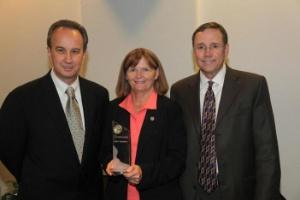TerrorismLAPD shows the way in local counterror efforts
Commander Joan T. McNamara, who heads the LAPD Counter-Terrorism and Criminal Intelligence Bureau, has devised a method which is considered so inexpensive, easily implemented, and innovative that federal authorities are considering making it a national model for local law enforcement intelligence gathering

LAPD Cmdr. Joan McNamara at MIPT award presentation // Source: lapd.com
In the years following the 9/11 attacks, federal authorities have been asking the 17,000 U.S. local law enforcement agencies to man the front lines in domestic counterterrorism by gathering information about crimes and other suspicious activities that may indicate an impending attack.
For various reasons, the idea has not been implemented as hoped. The local agencies have gathered information in haphazard ways, authorities say, or in many cases not at all. Most police offficers are trained to gather evidence to prove crimes, not to cultivate , gather, and analyze intelligence to prevent a terrorist strike.
Commander Joan T. McNamara, who heads the LAPD Counter-Terrorism and Criminal Intelligence Bureau, has devised a method which is considered so inexpensive, easily implemented, and innovative that federal authorities are considering making it a national model for local law enforcement intelligence gathering.
McNamara added a section to the form that officers must fill out for crimes, real or suspected. The added section includes a checklist that codifies activities usually associated with terrorist activity. These forms must be filled out if the officers observe suspicious activity, whether or not a crime has been committed.
There is also a check box that indicates that the form includes suspicious activity. If that box is checked, the form is forwarded to a special unit that analyzes the data and enters it into a database for further comparative analysis, and is available to other law enforcement agencies.
Over the recent months, all LAPD officers have been receiving training in how to execute the forms, and in what forms of suspicious activity to watch for, based on the sixty-five item checklist which is included on the form.
The checklist itself includes items such as someone conducting surveillance on a government building, attempting to purchase explosives or explosive components, openly espousing extremist views, or abandoning a suspicious package.
McNamara brought her idea to Police Chief William Bratton, former NYPD chief, who embraced the idea enthusiastically. The U.S. Directorate of National Intelligence became interested, and this month is dispatching teams of experts to Chicago and Boston to test the program in those cities, prior to a nation-wide rollout.
